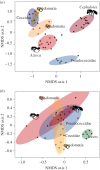Community analysis of microbial sharing and specialization in a Costa Rican ant-plant-hemipteran symbiosis
- PMID: 28298351
- PMCID: PMC5360929
- DOI: 10.1098/rspb.2016.2770
Community analysis of microbial sharing and specialization in a Costa Rican ant-plant-hemipteran symbiosis
Abstract
Ants have long been renowned for their intimate mutualisms with trophobionts and plants and more recently appreciated for their widespread and diverse interactions with microbes. An open question in symbiosis research is the extent to which environmental influence, including the exchange of microbes between interacting macroorganisms, affects the composition and function of symbiotic microbial communities. Here we approached this question by investigating symbiosis within symbiosis. Ant-plant-hemipteran symbioses are hallmarks of tropical ecosystems that produce persistent close contact among the macroorganism partners, which then have substantial opportunity to exchange symbiotic microbes. We used metabarcoding and quantitative PCR to examine community structure of both bacteria and fungi in a Neotropical ant-plant-scale-insect symbiosis. Both phloem-feeding scale insects and honeydew-feeding ants make use of microbial symbionts to subsist on phloem-derived diets of suboptimal nutritional quality. Among the insects examined here, Cephalotes ants and pseudococcid scale insects had the most specialized bacterial symbionts, whereas Azteca ants appeared to consume or associate with more fungi than bacteria, and coccid scale insects were associated with unusually diverse bacterial communities. Despite these differences, we also identified apparent sharing of microbes among the macro-partners. How microbial exchanges affect the consumer-resource interactions that shape the evolution of ant-plant-hemipteran symbioses is an exciting question that awaits further research.
Keywords: Cordia alliodora; bacteria; fungi; metabarcoding; myrmecophyte; scale insects.
© 2017 The Author(s).
Figures




Similar articles
-
Water stress strengthens mutualism among ants, trees, and scale insects.PLoS Biol. 2013 Nov;11(11):e1001705. doi: 10.1371/journal.pbio.1001705. Epub 2013 Nov 5. PLoS Biol. 2013. PMID: 24223521 Free PMC article.
-
Ecological consequences of interactions between ants and honeydew-producing insects.Proc Biol Sci. 2007 Jan 22;274(1607):151-64. doi: 10.1098/rspb.2006.3701. Proc Biol Sci. 2007. PMID: 17148245 Free PMC article. Review.
-
Current issues in the evolutionary ecology of ant-plant symbioses.New Phytol. 2014 May;202(3):749-764. doi: 10.1111/nph.12690. Epub 2014 Jan 21. New Phytol. 2014. PMID: 24444030 Review.
-
Harnessing ant defence at fruits reduces bruchid seed predation in a symbiotic ant-plant mutualism.Proc Biol Sci. 2014 May 7;281(1785):20140474. doi: 10.1098/rspb.2014.0474. Print 2014 Jun 22. Proc Biol Sci. 2014. PMID: 24807259 Free PMC article.
-
Bacterial gut symbionts are tightly linked with the evolution of herbivory in ants.Proc Natl Acad Sci U S A. 2009 Dec 15;106(50):21236-41. doi: 10.1073/pnas.0907926106. Epub 2009 Nov 30. Proc Natl Acad Sci U S A. 2009. PMID: 19948964 Free PMC article.
Cited by
-
Bacterial diversity in arboreal ant nesting spaces is linked to colony developmental stage.Commun Biol. 2023 Nov 30;6(1):1217. doi: 10.1038/s42003-023-05577-5. Commun Biol. 2023. PMID: 38036598 Free PMC article.
-
Can social partnerships influence the microbiome? Insights from ant farmers and their trophobiont mutualists.Mol Ecol. 2018 Apr;27(8):1898-1914. doi: 10.1111/mec.14506. Epub 2018 Mar 15. Mol Ecol. 2018. PMID: 29411455 Free PMC article.
-
Symbiotic Bacteria Regulating Insect-Insect/Fungus/Virus Mutualism.Insects. 2023 Sep 3;14(9):741. doi: 10.3390/insects14090741. Insects. 2023. PMID: 37754709 Free PMC article. Review.
-
Azteca ants maintain unique microbiomes across functionally distinct nest chambers.Proc Biol Sci. 2019 Aug 14;286(1908):20191026. doi: 10.1098/rspb.2019.1026. Epub 2019 Aug 7. Proc Biol Sci. 2019. PMID: 31387509 Free PMC article.
-
Untangling the complex interactions between turtle ants and their microbial partners.Anim Microbiome. 2023 Jan 3;5(1):1. doi: 10.1186/s42523-022-00223-7. Anim Microbiome. 2023. PMID: 36597141 Free PMC article.
References
-
- Bronstein JL. 2015. Mutualism, 297 p. Oxford, UK: Oxford University Press.
-
- Douglas AE. 2015. The special case of symbioses: mutualisms with persistent contact. In Mutualism (ed. Bronstein JL.), pp. 20–34. Oxford, UK: Oxford University Press.
-
- Bronstein JL. 1998. The contribution of ant-plant protection studies to our understanding of mutualism. Biotropica 30, 150–161. (10.1111/j.1744-7429.1998.tb00050.x) - DOI
MeSH terms
LinkOut - more resources
Full Text Sources
Other Literature Sources
Medical

